
|
|
15 October, 2004
Our first full day here!
It seems like longer, since I went to bed after 1 a.m. and got up early. Although the sun sets, it never gets dark. When I left the computer room after midnight, it was hard to believe it was so late, and it was incredibly beautiful.
We've already seen and done a lot today. This morning there was setup to be done in the lab. The lab space consists of large room with a "wet" side and a "dry" side. The dry side is for computers and other things that obviously can't get wet. On the other side, there is space for sorting out and preserving samples taken from the benthos, as well as a microscope for looking at plankton samples. On the way in to the lab, other scientists have aquariums with animals that include sea stars, sea urchins, brittle stars, and cod. This afternoon, the sea stars were spawning - releasing sperm and eggs into the water, where, if they meet, they form an embryo.
Next, at 9:00, we had driver training. There are all kinds of vehicles here, from four-wheel drive vans with large tires to little tracked vehicles, like the Pisten Bully. First you have a slide show to orient you to driving at the station. This alerts you to problems you might not ever think about - for example, when you park a truck or a van, you should always park facing into the wind. This is because the doors can get dented or even blown off if you park so that the wind can catch them. If you're driving the Pisten Bully, though, you park it in the opposite direction because the doors open from the front. You also need to put chocks behind the wheels of the truck whenever you park it, so it doesn't roll or slide away.
Then, at 9:30, there was the science briefing, where we met with all the people at the station who support the science. In order to do a research project, especially one that involves diving, there are all kinds of things that have to be coordinated. There are people who deal with communications, such as the radios that go into the field, people who deal with helicopter transport and transport by vehicle, and people who deal with shipping samples from McMurdo back to the U.S. There is the group that makes the "dive cookies" - round covers that go over the holes that are cut in the ice for diving, and people whose job is to make sure we comply with all the environmental and conservation regulations. And last, but definitely not least, there is the dive coordinator, who ensures that all the needed dive equipment is available, including the dive huts and safety equipment, and checks to make sure that everyone is comfortable with their equipment and can use it with ease. The plan
ning that goes into a project like this is amazing - if you forget something important, you can't just run out to Wal-Mart to get it!
Another thing that needed to be set up this morning was the dive gear hut located outside the lab. This is where the divers will suit up in the morning, then travel to the dive sites, except for the more remote sites, where they will start their day from a field camp. It is basically a little wooden one-roomed "house" with racks for hanging dive gear and a stove to help keep the divers and dive tenders (assistants) warm, and to dry out the gear. It's nice and toasty inside, but when a diver comes up from a dive, it still takes a while to warm up and the divers REALLY like a dive tender who has hot chocolate ready for them as soon as they come up from the dive.
Rob Robbins, the science diving coordinator, met with all the divers in our group today. He said that there are 27 divers working on various projects out of McMurdo right now - a high number. He went over the dive equipment, as well as the emergency kit that goes along on all dives and contains bottled oxygen. The dive equipment used in Antarctica is basically similar to what would be used in New England in the winter. One major difference is that the air tanks have a branched "Y" valve for two regulators that take air from the tank to the diver. While people usually dive with two 'second stage's (the part that goes in your mouth), the spare one is generally there for a diver's buddy to use in case they run out of air or have an equipment failure. Here, the water is so cold that it's not uncommon for the regulator to have problems with freezing that can cause it to "free-flow." When this happens, instead of air being delivered into the diver's mouth every time he or she breat
hes in, the air comes rushing out in a big, uncontrolled gush. Not only is the diver unable to breathe from the tank when this happens, but the air is lost very quickly. But with the "Y" system, the diver can shut off the free-flowing air, turn on the other regulator, and breathe from that. One problem, though, is that the diver's mouth is already so numb that it's hard to find it to get the new regulator in!
At 3:00 we had our driving lessons with Elizabeth Traver. She was patient even though we were her fourth group of the day that had to be trained on driving the vehicles here at McMurdo. We practiced on three vehicles: a pickup truck with big tires, a Mattracks - a pickup truck with tracks instead of wheels, and the Pisten Bully. Because of the cold and the fact that all the roads are either dirt or ice, as well as the fact that all different people are driving the vehicles, they have to be carefully inspected before use. Driving the pickup truck was similar to driving at home. The Mattracks required thinking in advance before you make a turn because it's much slower to turn than a regular wheeled vehicle. The Pisten Bully is the most different and the most fun. It turns REALLY easily - you can practically spin it around in place. It also has heated seats! This is the vehicle that will be used to travel to the nearby dive sites every day.
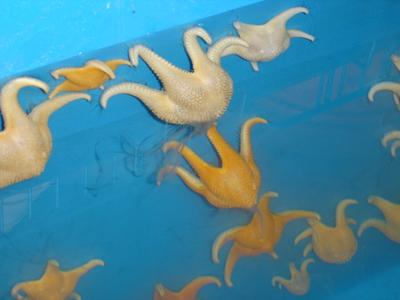
1. Antarctic sea stars
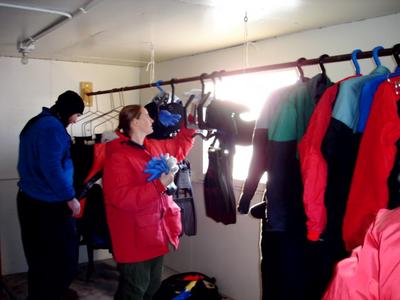
2. Organizing the dive gear in the hut.
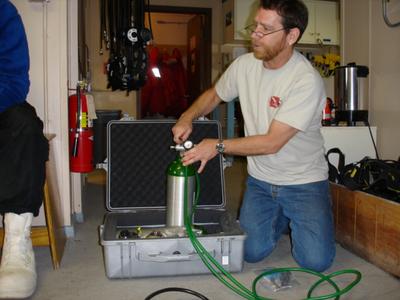
3. Dive coordinator Rob Robbins shows the emergency oxygen bottles.

4. A dive tank with two regulators.
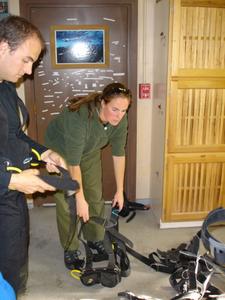
5. Andrew and Jennifer try on their weight belts. Divers must wear weights or else they will just float at the surface.

6. The dive gear hut (left) and the Pisten Bully.
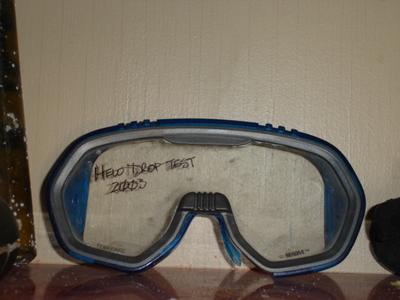
7. This mask survived being dropped from a helicopter!

8. Driving test - back up, turn left, turn right, go forward and park.

9. A Mattracks

10. Look out! Madwoman at the wheel!
Contact the TEA in the field at
.
If you cannot connect through your browser, copy the
TEA's e-mail address in the "To:" line of
your favorite e-mail package.
|
